Transforming Teamwork With VDC
Critical infrastructure upgrades are often large, complex projects with tight schedules and little room for budget overruns. Small inconsistencies have the potential to slow project delivery with unexpected obstacles and change orders, threatening costly delays. Designers and constructors have historically found themselves at odds when something needs to change mid-project; but this is now changing as project teams integrate virtual design and construction (VDC) technologies into their workflow. Using tools that combine real-world structures with virtually planned improvements, project teams are honing into details in a collaboratively shared, real-time 3D environment that’s changing the way designers and builders plan, work, interact and understand one another.
VDC, the process of how a 3D or building information model (BIM) tool is used throughout project delivery, uses a combination of technologies and processes to create an accurate working model that you can add data to as project delivery progresses. With VDC, you can accurately map existing structures without current as-built documentation; compare designs across disciplines and find conflicts early on; visualize data within a model to calculate material quantity, track schedule and iteratively strategize process flow; get real-time updates; all while working in one, all-inclusive platform.
|
|
Reading the Room, Scanner Style |
In some cases, the first step to creating a 3D model is to perform laser scanning—a method for mapping an existing environment and collecting data that can be processed into a highly accurate 3D model equipped with measurements. Complex retrofitting jobs and facility expansions benefit most from scanning. Kerr Lake Regional Water System, located in Henderson, North Carolina is using laser scanning and VDC to help deliver a facility upgrade for its Kerr Lake Water Treatment Plant (WTP). When finished, the upgrade will expand the facility, connecting the existing structures to new structures to upgrade water treatment capacity from 10 to 20 million gallons per day.
Laser scanning allows us to map a facility by quickly creating a 3D model of existing structures, without the need for historical drawings.
When existing documentation is difficult to interpret or is missing, scanning helps fill in the blanks. The Kerr Lake WTP is an ideal use case for laser scanning, because the expansion will connect existing parts of the plant to new parts that have yet to be constructed. “We don’t have robust documentation of changes made since the plant opened in 1974,” said Todd Smith, CDM Smith design manager and associate. “Record drawings were somewhat foreign back then.” To overcome this challenge, the project team uses a 360-degree laser scanner able to collect nearly one million measurements per second that can be processed to help build or add to 3D models.
Architect and intelligent modeling coordinator Clarice Sollog recalls the nature of project delivery prior to the advent of laser scanning. “We previously relied on 2D record drawings that aren’t always current,” said Sollog. “Now, scanning gives us a snapshot of what actually exists, creating consistency across disciplines and alleviating coordination issues.” Throughout construction, the 3D model can be updated with new scans as structures are built. In Kerr Lake’s case, the 3D model will eventually become an up-to-date as-built CAD file of the new plant when project construction is completed. “That’s the as-built difference,” said CDM Smith construction manager, Steve Solters. “Everyone is looking at the same thing and you’re not making interpretations from an historical drawing."

When investing millions of dollars in a facility, you need to know exactly where everything is. VDC allows us to quickly map an environment in 3D.

Clash detection is a great way to bring designers and constructors together in a shared ecosystem and find issues between disciplines.
|
|
A Living Dataset |
Once you have a working 3D model, there’s no shortage of downstream uses and benefits. The 3D model acts as a continuous dataset with a level of accuracy most clients have never experienced. “As a team, we want to be working in 3D,” said CDM Smith client service leader Reed Barton. “Both the design team and the Owner can virtually walk through a designed space on a computer screen or using HoloLens mixed reality technology to understand the new facility before it is ever constructed.” Stakeholders can visualize the end-product while project engineers, planners and constructors delve into the details. Working in 3D is helping the Kerr Lake team to take these technologies to the next level, using existing tools to encourage a new level of collaboration. “You see coordination improve working in 3D. You see real time updates from other disciplines so you’re really able to coordinate on the fly,” said Sollog.
The team used its model to compare designs between disciplines, a process known as clash detection. The model is used to overlay designs—from mechanical to structural to electric and plumbing—and identify elements that conflict or create unsafe conditions. “This is a great way to bring designers and constructors together in a shared ecosystem and find issues between disciplines,” said Sollog. This provides a level of transparency that can encourage discussion and surface concerns early in delivery, expediting collaborative problem-solving.
“Clash detection has defined and uncovered conflicts we didn’t anticipate. It’s better to find conflicts now rather than in the field when I’m holding four or five pipe fitters wondering how we’re going to make it work,” said Solters. The benefits are simple yet impactful: it’s far less costly to collaborate on a 3D model and change a design early on than it is to make changes to a completed structure.
When the Kerr Lake WTP expansion is finished, the plant will have an up-to-date 3D model that can serve as an as-built. The next time KLWRS wants to make upgrades or changes, its staff can be confident that the as-built documentation is current.
|
|
Designing, Constructing and Communicating in the Future |
Sometimes, the innovation isn’t in the technology, but in the way we communicate. What VDC does is bring the whole project team together to work toward a shared goal. Whether that goal is distributing a dataset, reaching a key milestone or delivering an entire facility at the end of a project, this game-changing process is challenging us to redefine project execution. “I believe that in the future, everything will be virtually designed and constructed, and we'll be using virtual reality to walk stakeholders through the designed plant,” said Solters. “The onsite innovation of computer design, especially 3D modeling, will revolutionize the construction and engineering industry. And it’s already started.”











